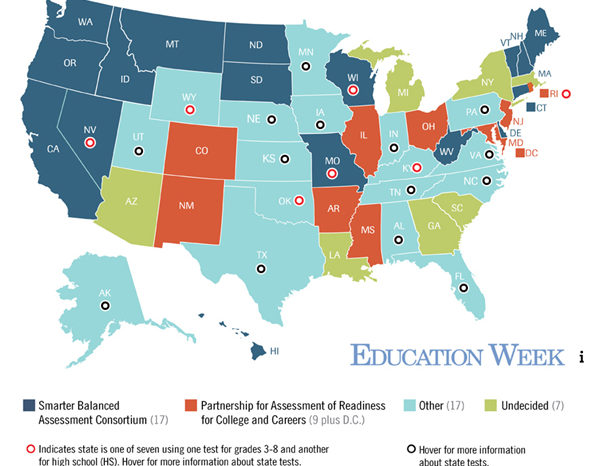A Fractured Testing Landscape
One of the benefits of waking up at 3 am to do some work is that you get to read everything without interruption from kids who have questions about their Common Core-aligned homework.
EdWeek just emailed out this nifty map on the status of testing plans for states in the US.
It interested me for a number of reasons but here is my list of four big takeaways:
- What will happen to the ever dwindling PARCC? Nine states? They started out with 25 states participating and now they are down to 9? (Just a year ago, according to the USED, they stood at 19.) How tenable with that be going forward given that with fewer states come fewer student customers and therefore higher per-student costs? Even with Massachusetts (a likely adopter) and perhaps another couple of states, the prospects for PARCC are grim. Meanwhile, in Massachusetts, we are spending gobs of money field testing PARCC and getting ready to implement it fully.
- That SBAC has become the test of choice for states is nothing short of ironic, given that PARCC was to be the test most similar to Massachusetts’ MCAS. So much for building “reforms” in the image of the state that has demonstrated the most progress on national and international assessments.
- The 24 states in light green and sky blue are a big problem for the proponents of a “common” approach. Without a test to enforce the implementation of Common Core, these states will likely go off into all sorts of different paths. Given their hands-off approach to standards-setting (in as much as they decided to go the route of taking off-the-shelf standards provided by the CCSSO, the NGA’s lobbying arm and Achieve, Inc.), one cannot expect a lot of vision and drive regarding testing policy. Up until now, Common Core proponents have been able to lean on testing as the enforcement arm of the initiative. In these states, should they not ultimately adopt PARCC or SBAC, teacher evaluations will shoulder a tremendous burden and become the de facto enforcement mechanism for Common Core. What that means simply is this: Either the teachers associations and unions will pressure these states to adopt a Common Core aligned test or they will push back against both testing and teacher evaluations. My guess is the latter wins. That leaves these states likely in a worse position than before Common Core was a twinkle in DC-based consultants’ eyes: They will have a weak set of standards and the usual end-runs around accountability.
- One final takeaway. Mike Petrilli of the pro-Core Fordham Institute claimed at a forum on May 6th that only 4 states had pulled out of Common Core-aligned tests. He contorted his face when I noted that the number was far higher. Time for his DC-based organization to go out and see the country.
Follow me on twitter at @jimstergios, visit Pioneer’s website, or check out our education posts at the Rock The Schoolhouse blog.




